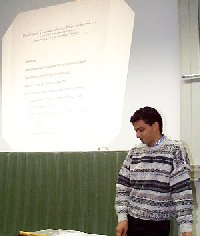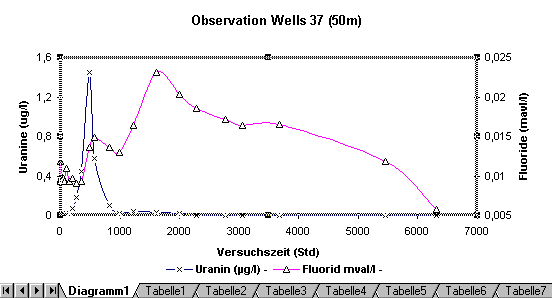Abstract

![]()

![]()
Über den Transport des Floridions in einem kalkalpinen Porengrundwasserleiter
Groundwater tests are an important tool for the determination of aquifer parameters: average interstitial velocity, seepage velocity, hydraulic conductivity kf, coefficiens of dispersion or diffusion.
Considering karst- and fissure groundwater the tracing of pore groundwater is subjected to some restrictions. At first there is comparatively little speed of flow in pore groundwater.
Therefore one has to count with longer lasting test periods in such a case. Then the contact with the rock surface is much more intensive than in fissure- and karst void spaces. This causes an increased sorption of cationic tracers. In the test field of Merdingen two tracing tests had carried with Uranin and Sodium-Fluoride.
The object is the comparison of Fluoride-ion to the Uranine and their suitability for the application in porous aquifers, the second reason is to determine the behavious of Fluoride in a highly permeable aquifere consisting of alluvial gravel.
The test field Merdingen is situated in the Upper Rhein Valley, southwest Germany, about 15 km northwest of Freiburg. It is set up in gravelplain between the two mountains, the Kaiserstuhl in NW an the Tuniberg in the S. The composition of the groundwater in the test field is typical for the groundwater in the alluvial sediments derived from the Alps. Due to the high amount of Carbonate components it is characterized by the dominance of Calcium and Hydrogencarbonat with total amount of dissolved components of about 700 mg/l.
The test field consists of more or less parellel fan shaped well sets together with 50 wells. It is arranged with his axes in the ground water flow direction towards NE.
The observation wells are positioned along circular arches in a distance of 6.25 m, 12 m, 25 m, 50 m and 100 m from the main injection well. Water samples were tretieved with small pumps.
The following results should be noted:
1. Fluoride moves through complex formations in the groundwaterstream considerably slower than Uranine.
2. It should be pointed out however that the flow velocity of the groundwater at various depth levels within the aquifere differs markedly.
3. The introducted 814 g of Fluoride remains effective in the measuring sight from distance of 100 m.
4. Ion exchange is recognisable only with potassium.
An example of best fit curve for the transversal distribution of Uranine and Fluoride is
shown in following fig.

e-mail: nissoul@ruf.uni-freiburg.de
![]()